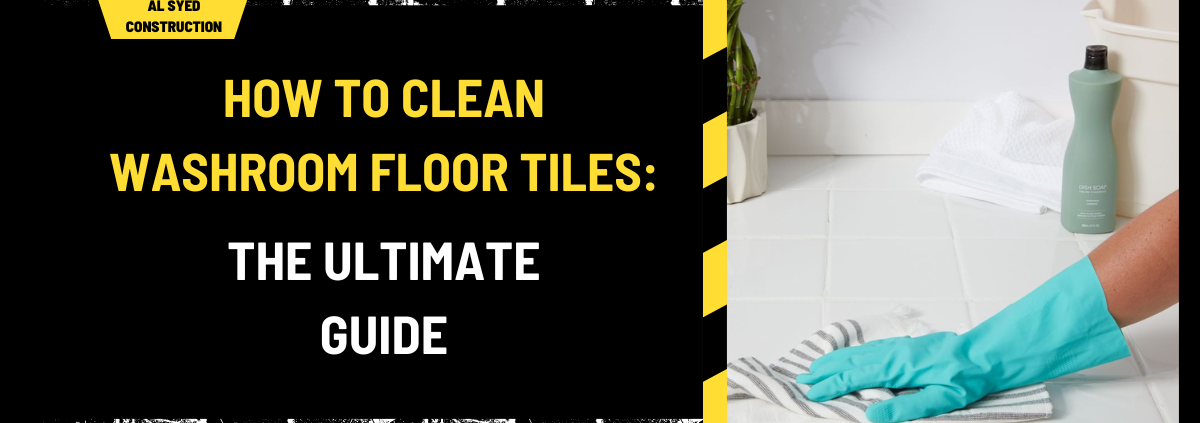How to Clean Washroom Floor Tiles: The Ultimate Guide
Maintaining the cleanliness of washroom floor tiles is crucial for both aesthetic appeal and hygiene. This comprehensive guide will provide detailed, step-by-step instructions to effectively clean and maintain your washroom floor tiles, ensuring they remain pristine and extend their longevity.
Table of Contents
Understanding Your Washroom Floor Tiles
1. Identify Tile Material
Before starting the cleaning process, it’s essential to identify the type of floor tiles in your washroom. Common materials include:
- Ceramic: Known for its durability and ease of maintenance.
- Porcelain: Highly resistant to stains and moisture.
- Natural Stone: Includes marble, granite, and travertine, which may require special care.
- Vinyl: Water-resistant and suitable for various designs.
2. Assess Tile Condition
Inspect your tiles for any damage or wear. Cracked or chipped tiles may require repair before cleaning to avoid worsening the damage.
Preparing for Cleaning
1. Gather Necessary Supplies
Ensure you have the following supplies ready:
- Broom or vacuum cleaner
- Mop with a microfiber head
- Bucket
- Tile cleaner or mild detergent
- Vinegar (for natural stone and grout)
- Baking soda (for tough stains)
- Grout brush (for grout lines)
- Clean cloths or sponges
2. Clear the Area
Remove all items from the floor, including rugs, mats, and any movable furniture. Sweep or vacuum the area to remove loose dirt and debris.
Cleaning Ceramic and Porcelain Tiles
1. Prepare Cleaning Solution
Mix a tile cleaner or mild detergent with warm water in a bucket. For a homemade solution, combine 1 cup of vinegar with 1 gallon of water. Avoid using harsh chemicals that could damage the tiles.
2. Mop the Floor
Dip a mop into the cleaning solution, wring out excess liquid, and mop the floor. Start at one corner and work your way towards the exit to avoid stepping on the freshly cleaned tiles.
3. Rinse and Dry
After mopping, rinse the mop in clean water and go over the floor to remove any remaining soap residue. Dry the tiles with a clean cloth or towel to prevent water spots and streaks.
Cleaning Natural Stone Tiles
1. Use a Gentle Cleaner
Natural stone tiles require a pH-balanced cleaner designed specifically for stone. Avoid acidic substances like vinegar, which can damage the stone surface.
2. Mop with Care
Apply the cleaner as per the manufacturer’s instructions and mop the floor gently. Use a mop with a soft head to avoid scratching the stone.
3. Rinse Thoroughly
Rinse the floor with clean water to remove all traces of the cleaner. Dry the surface with a clean cloth to prevent water spots and preserve the stone’s natural finish.
Cleaning Vinyl Tiles
1. Choose the Right Cleaner
For vinyl tiles, use a vinyl floor cleaner or a mixture of mild detergent and warm water. Avoid using too much water, as it can seep into the seams and cause damage.
2. Mop the Floor
Mop the floor with the cleaning solution, ensuring you don’t use excessive water. For stubborn spots, apply a small amount of cleaner directly to the area and scrub gently.
3. Dry the Floor
Use a clean, dry cloth or mop to remove excess moisture and ensure the vinyl tiles are thoroughly dried.
Deep Cleaning Grout Lines
1. Apply a Grout Cleaner
For grout lines, use a grout cleaner or a homemade paste of baking soda and water. Apply the cleaner to the grout lines and let it sit for 10-15 minutes.
2. Scrub the Grout
Use a grout brush or a toothbrush to scrub the grout lines thoroughly. Rinse with clean water and wipe away any residue with a damp cloth.
3. Seal the Grout
Consider applying a grout sealer after cleaning to protect the grout from stains and moisture. Follow the manufacturer’s instructions for application.
Maintaining Your Washroom Floor Tiles
1. Regular Cleaning Schedule
Establish a regular cleaning routine to keep your tiles looking their best. Sweep or vacuum the floor daily and mop weekly to prevent dirt buildup.
2. Address Spills Immediately
Clean up spills as soon as they occur to prevent staining and damage. Use a clean cloth to blot up the liquid and then clean the area with the appropriate tile cleaner.
3. Use Protective Mats
Place floor mats at entry points to reduce the amount of dirt and moisture tracked onto your tiles. Ensure the mats are regularly cleaned to maintain their effectiveness.
4. Repair Damage Promptly
Address any cracked or chipped tiles immediately to prevent further damage and maintain the overall appearance of your washroom floor.
Conclusion
Cleaning washroom floor tiles requires a tailored approach based on the type of tile and its condition. By following these detailed steps, you can ensure that your tiles remain clean, well-maintained, and in excellent condition for years to come.




